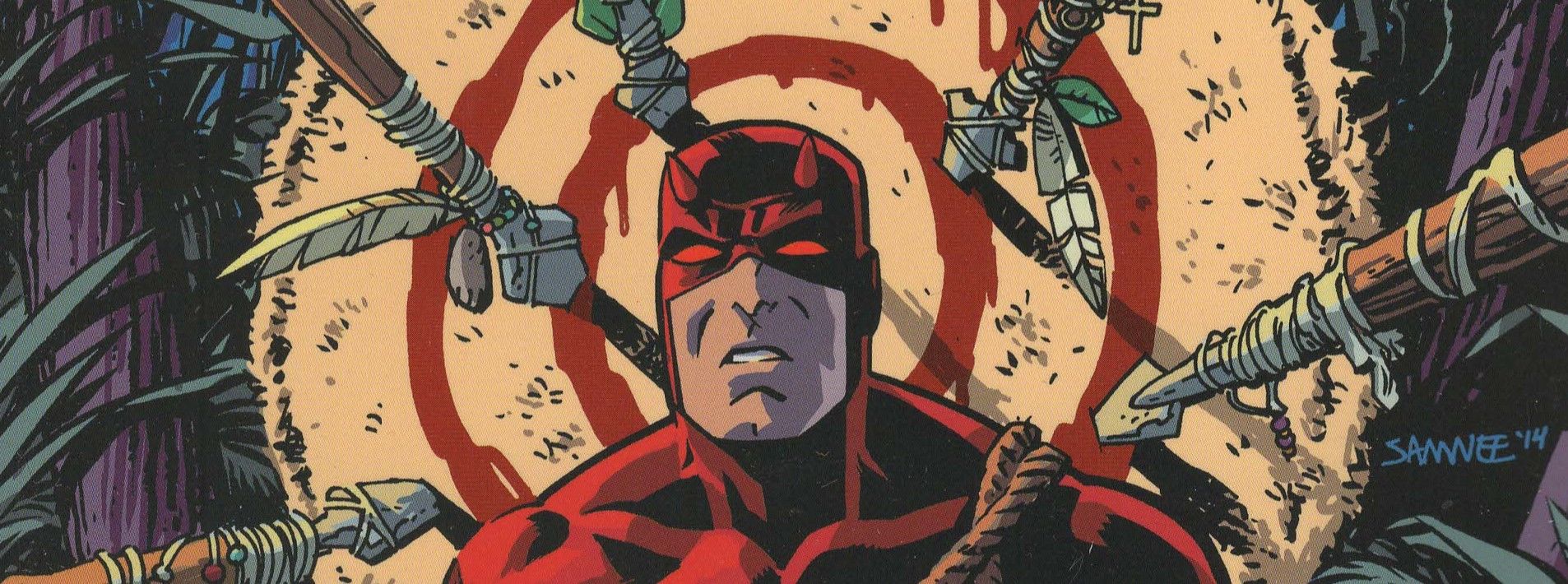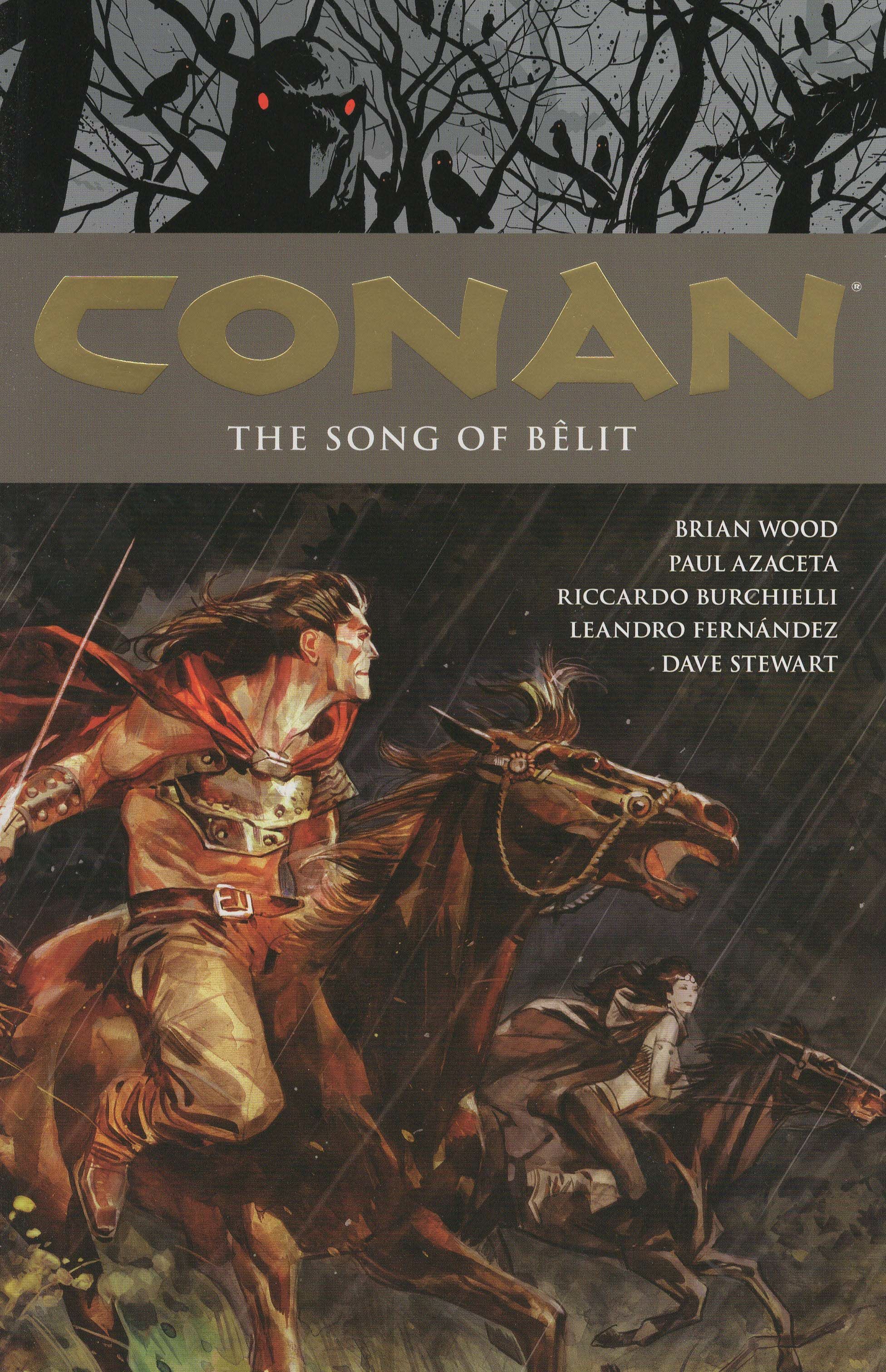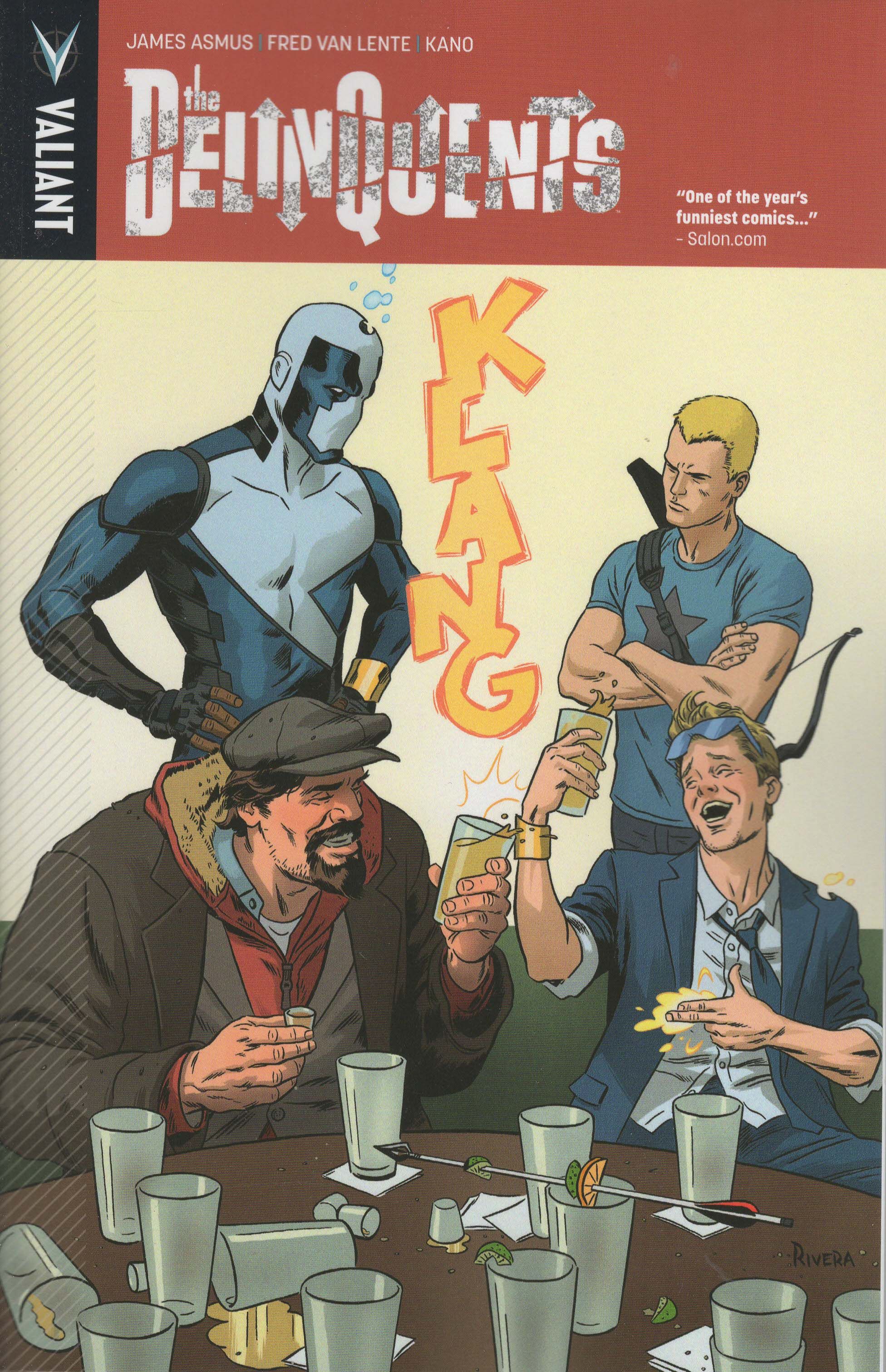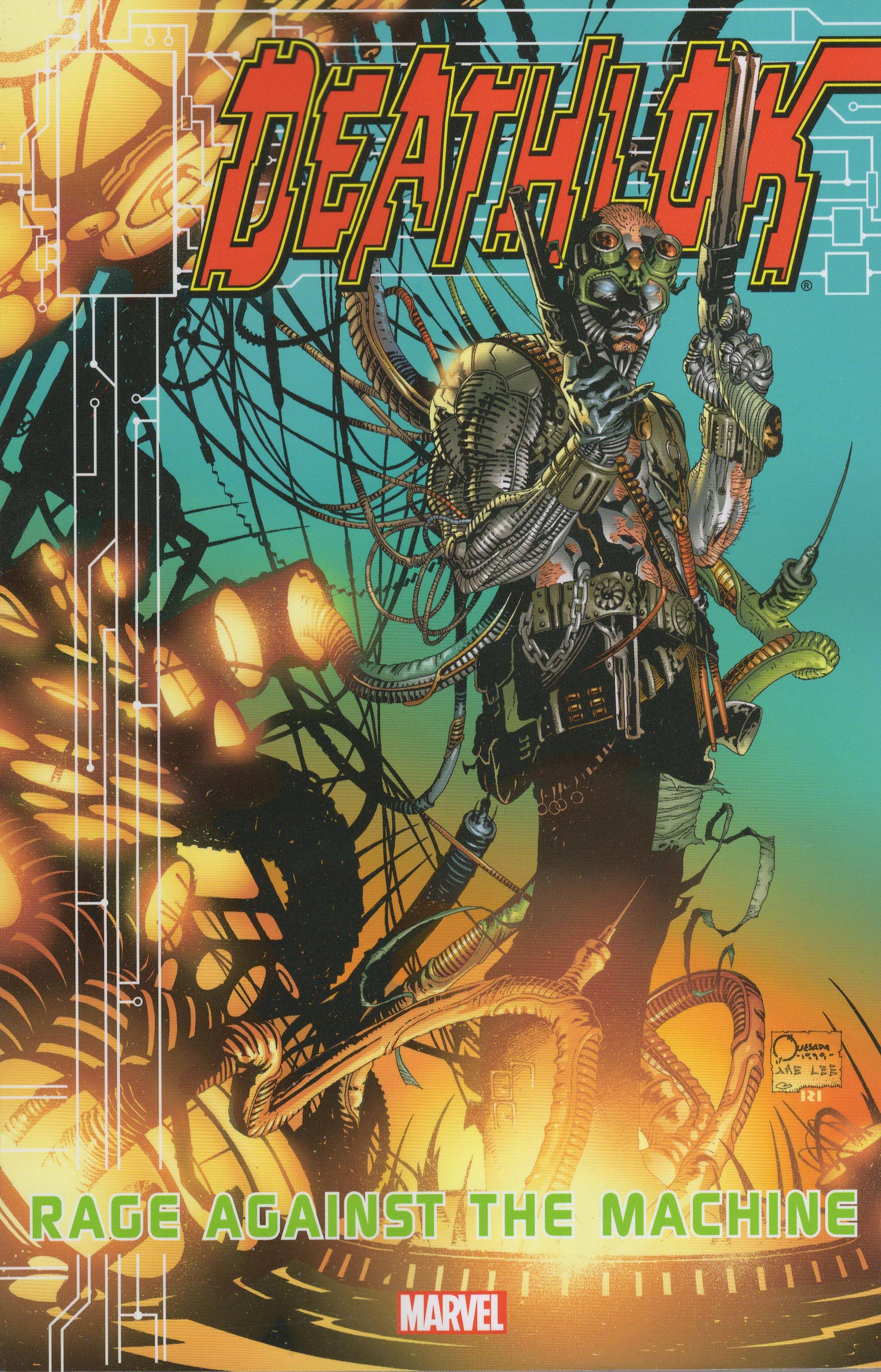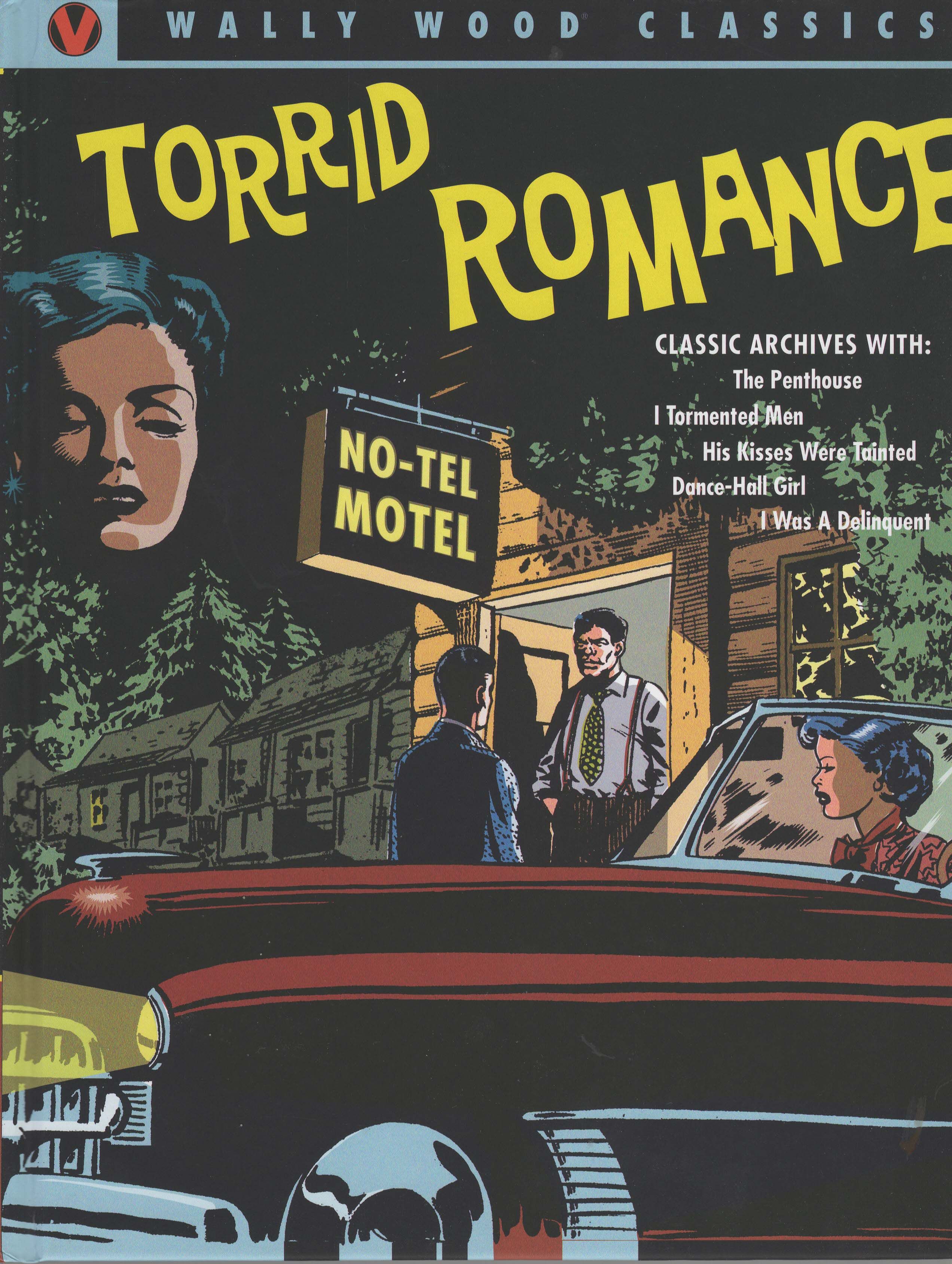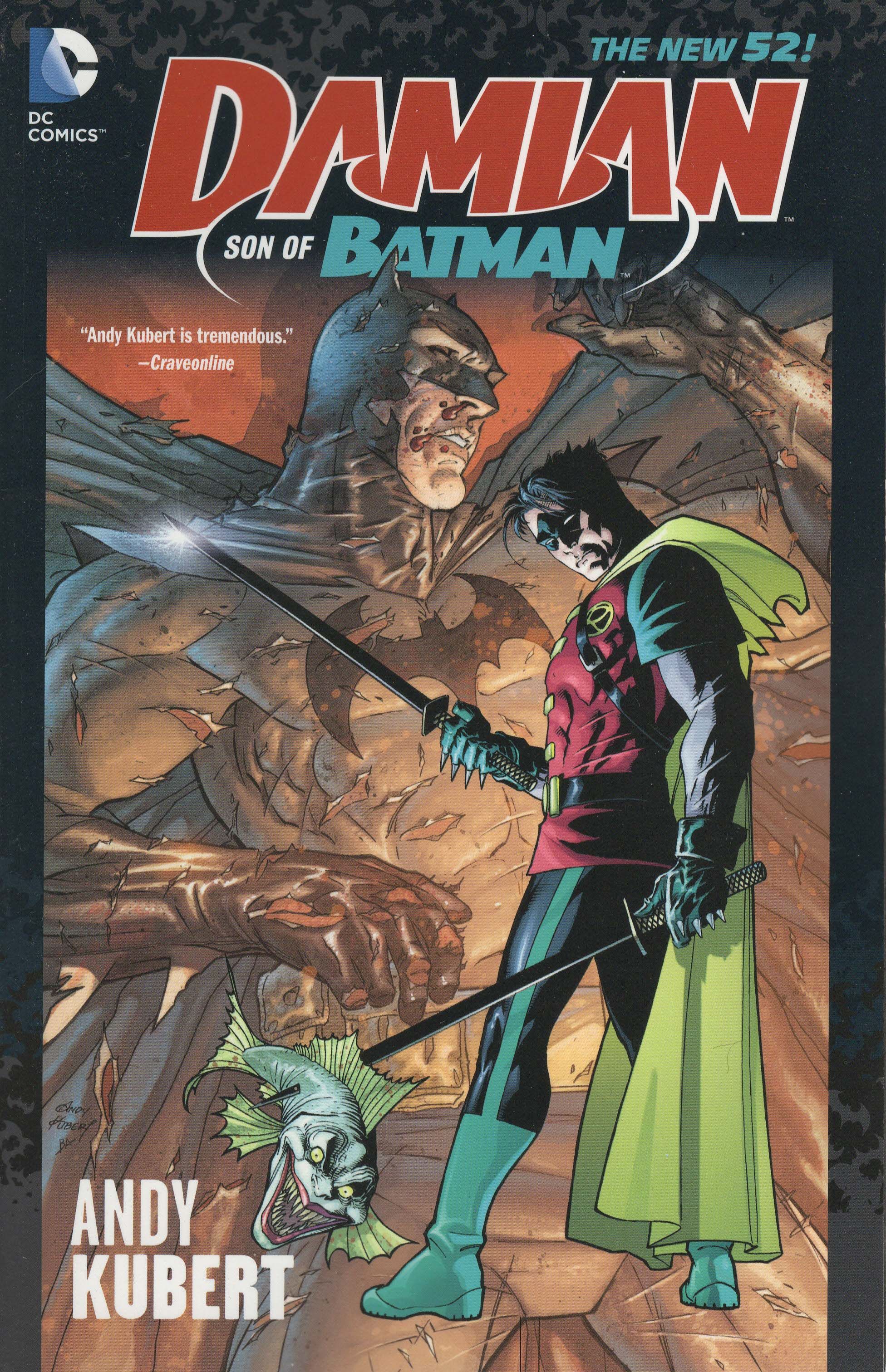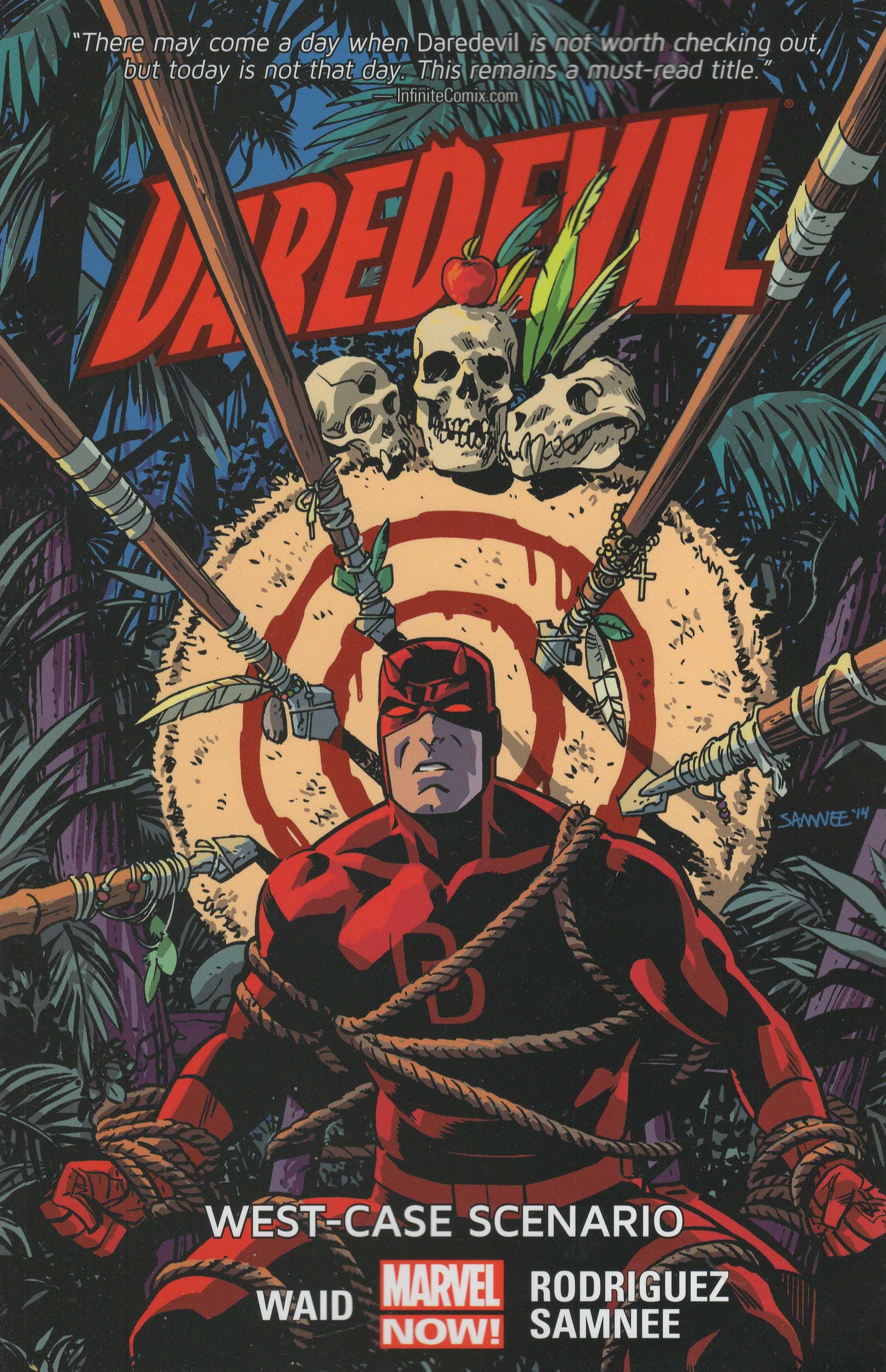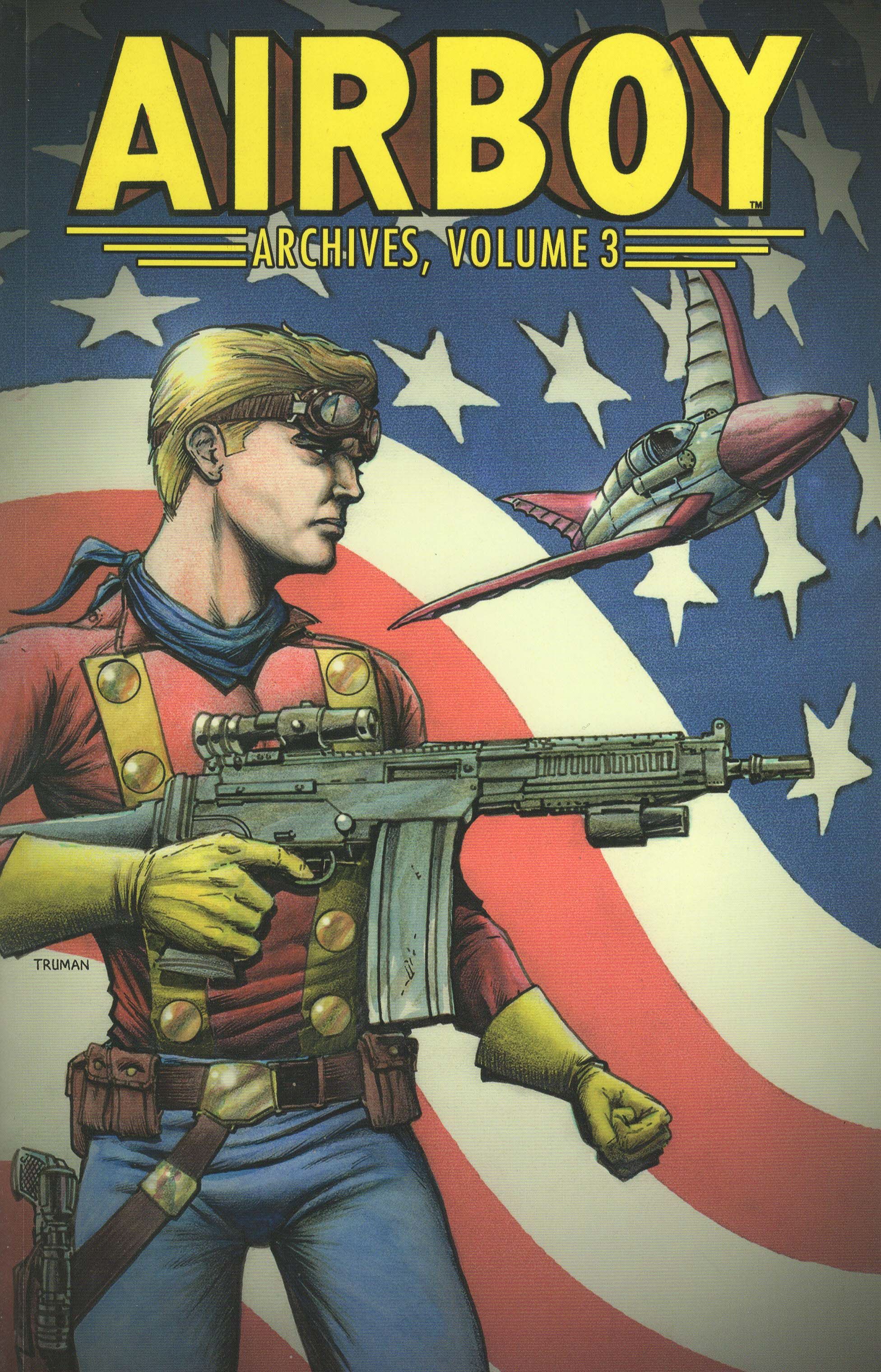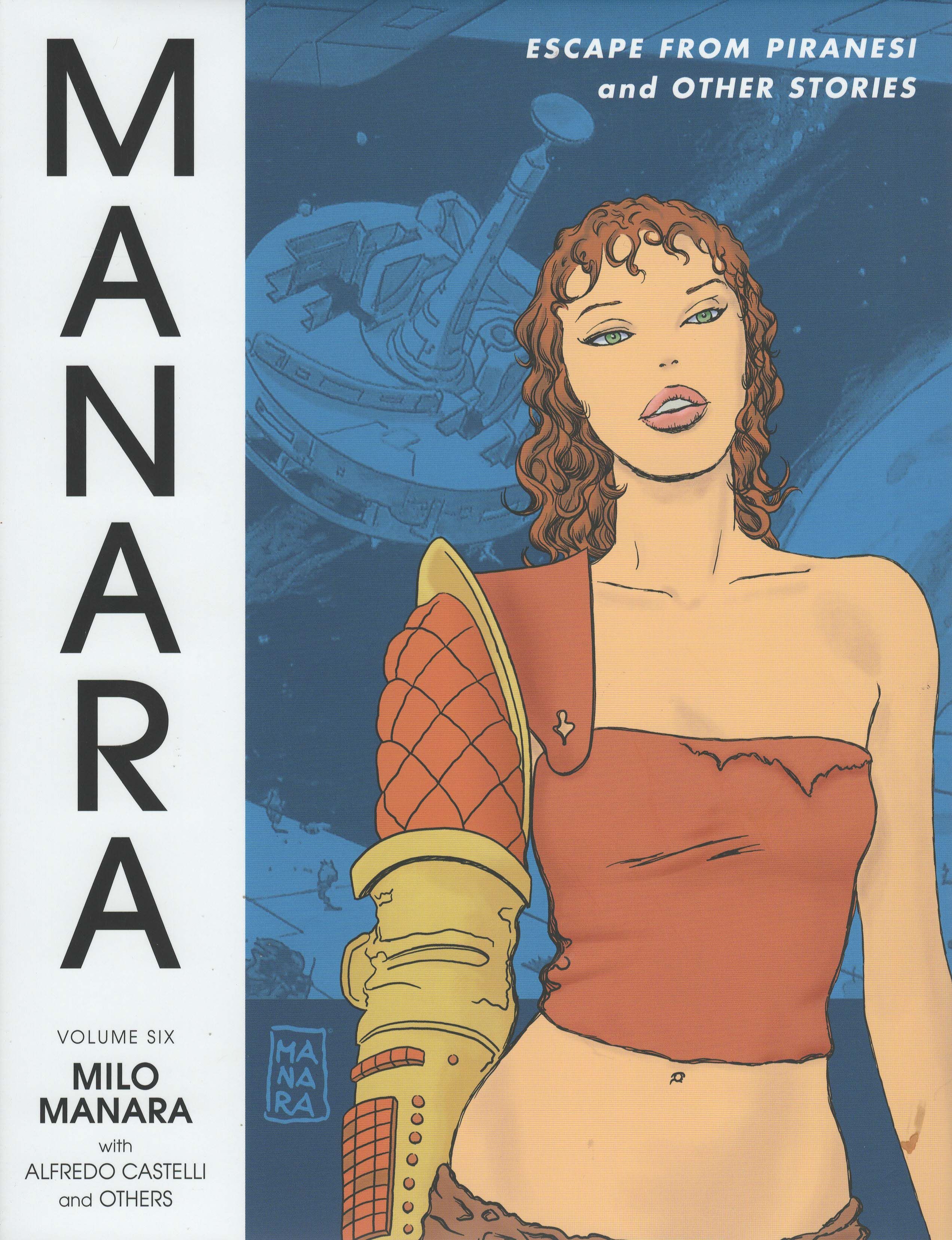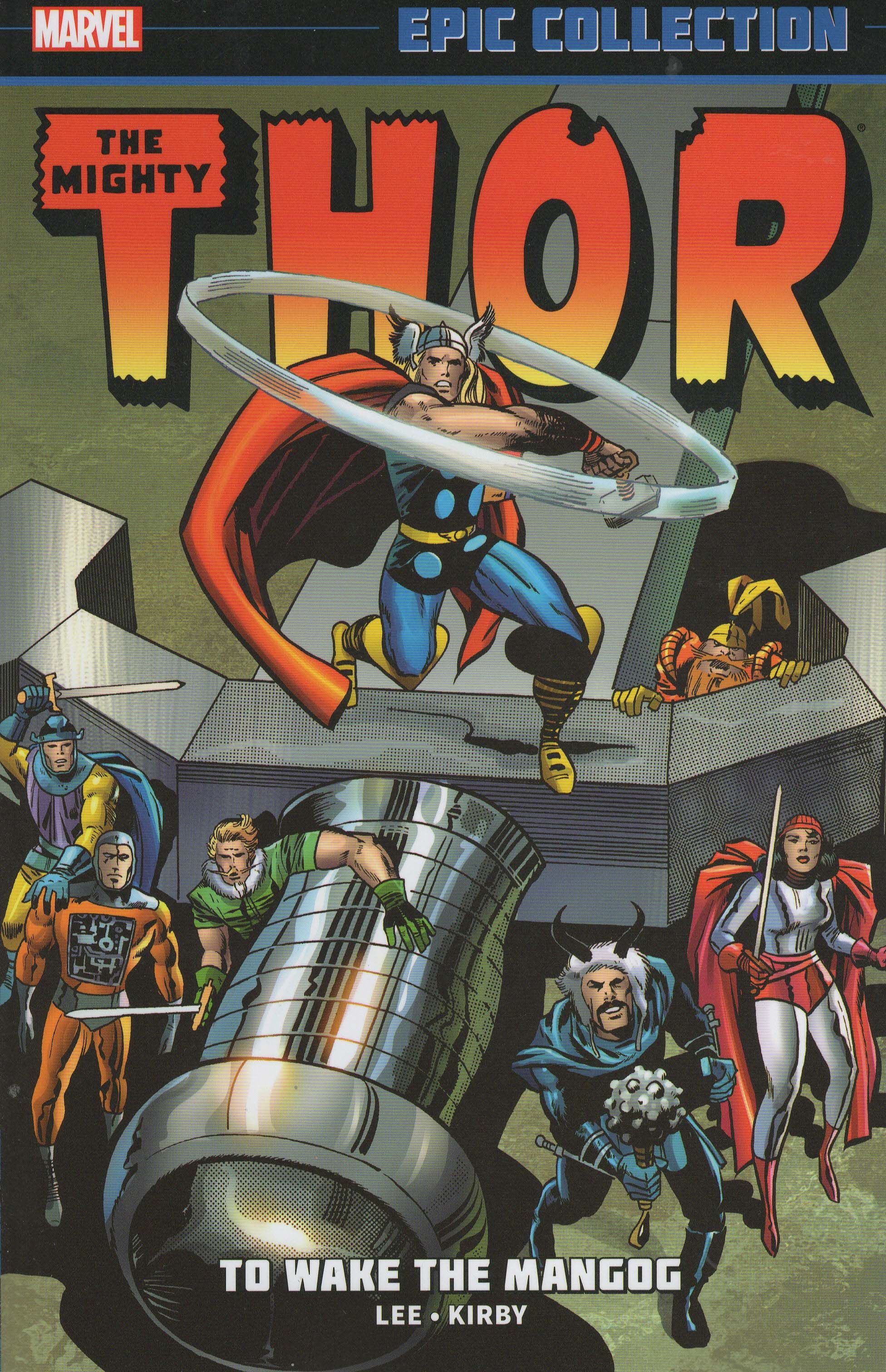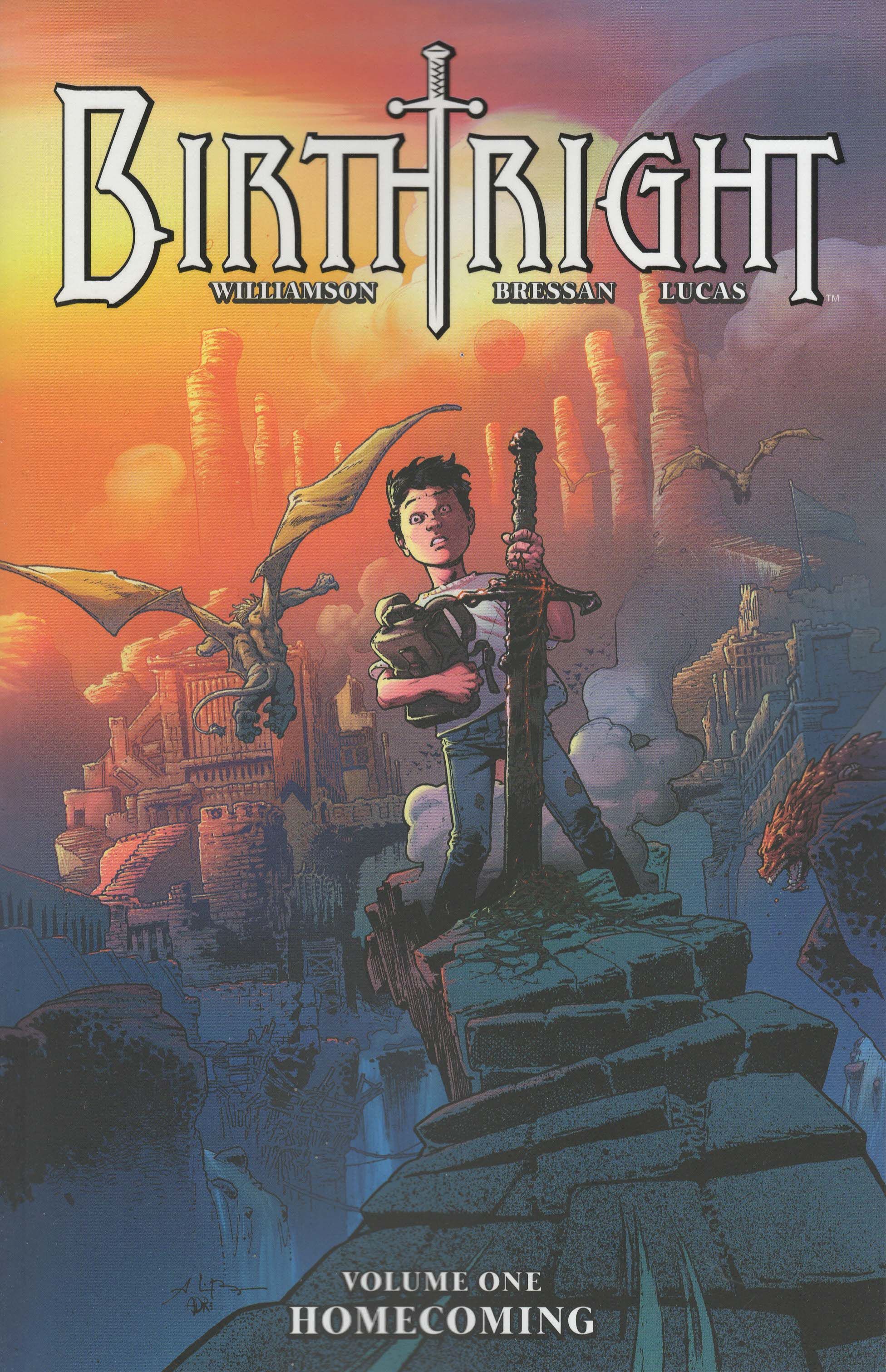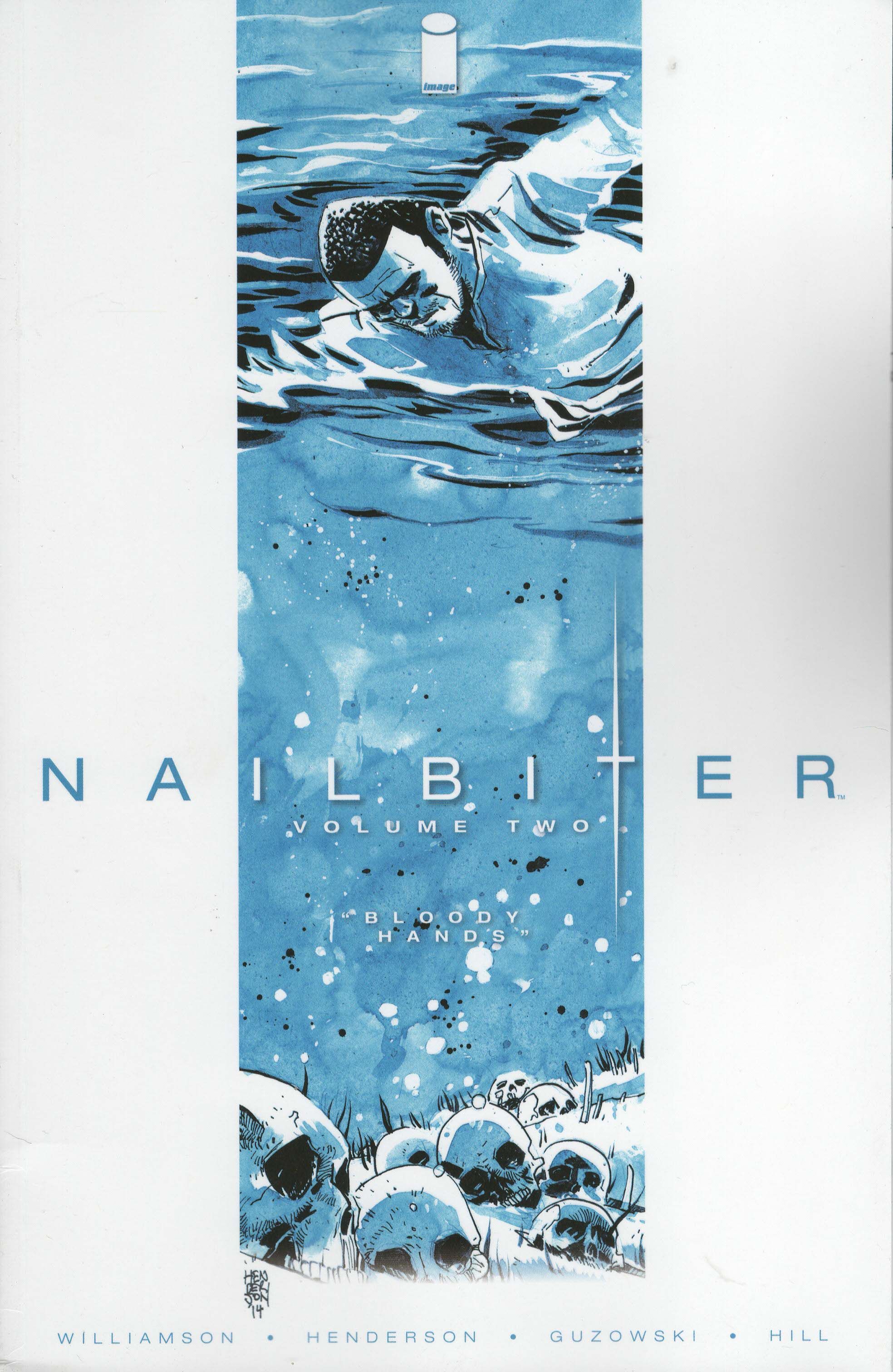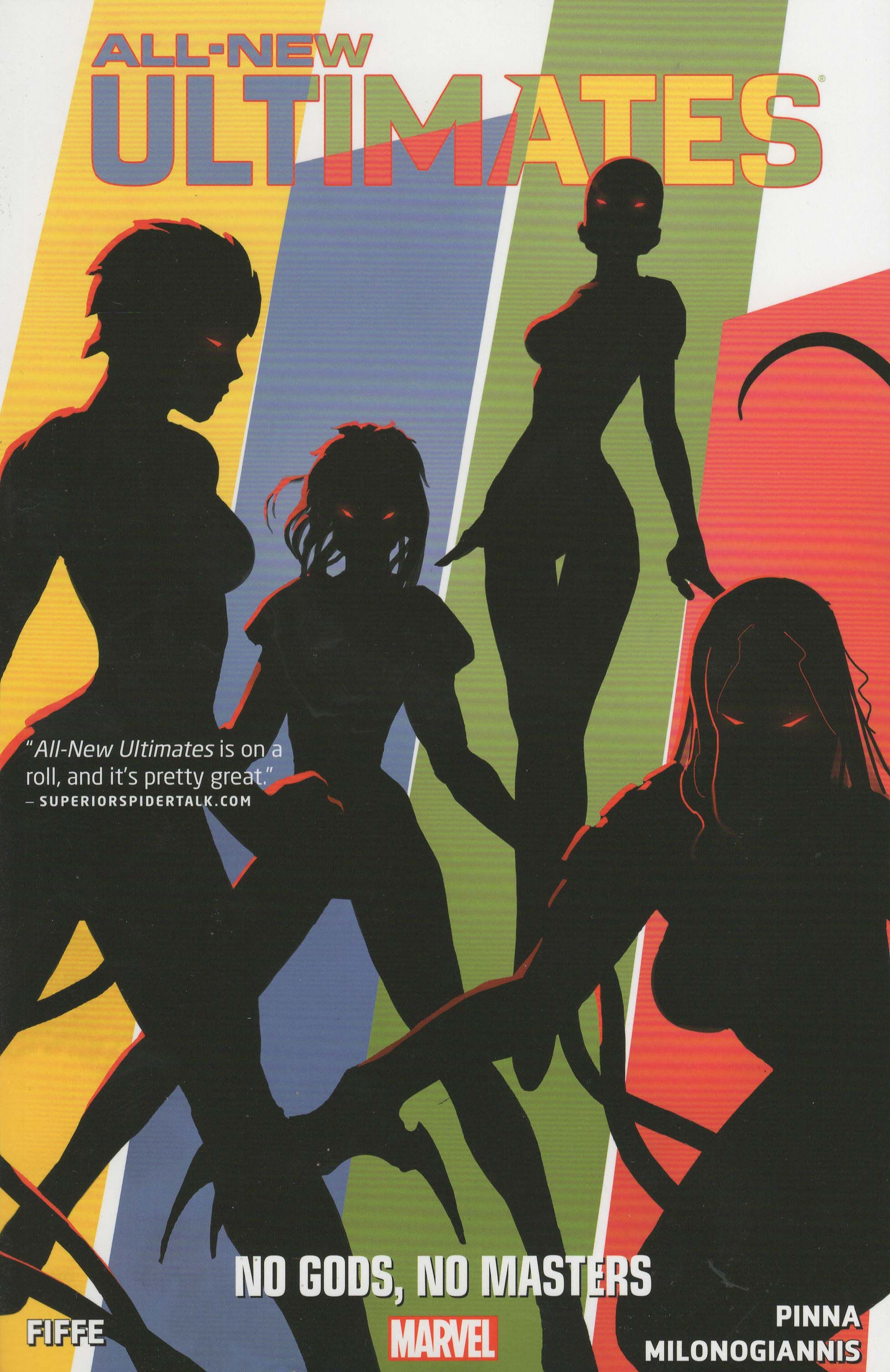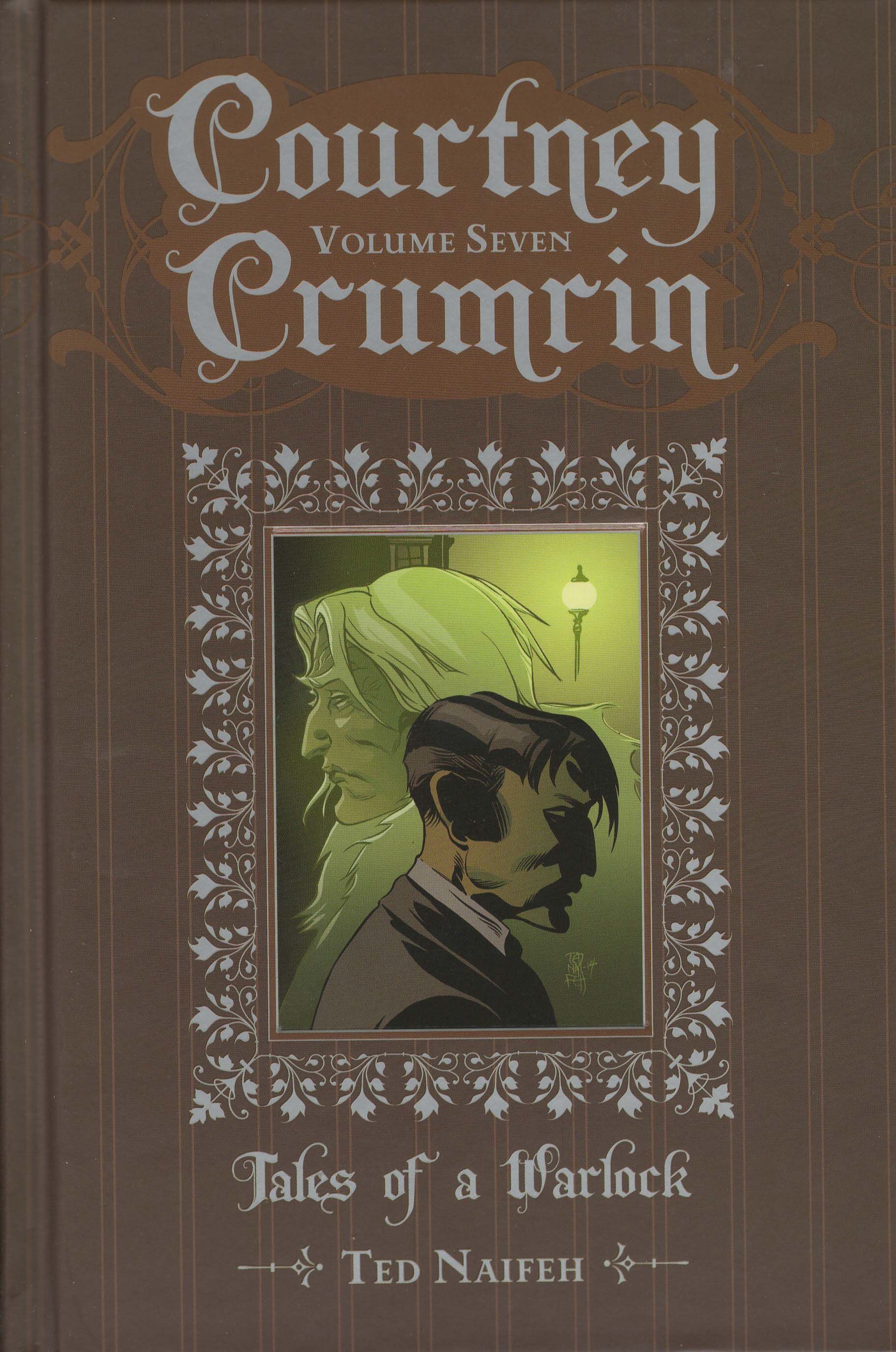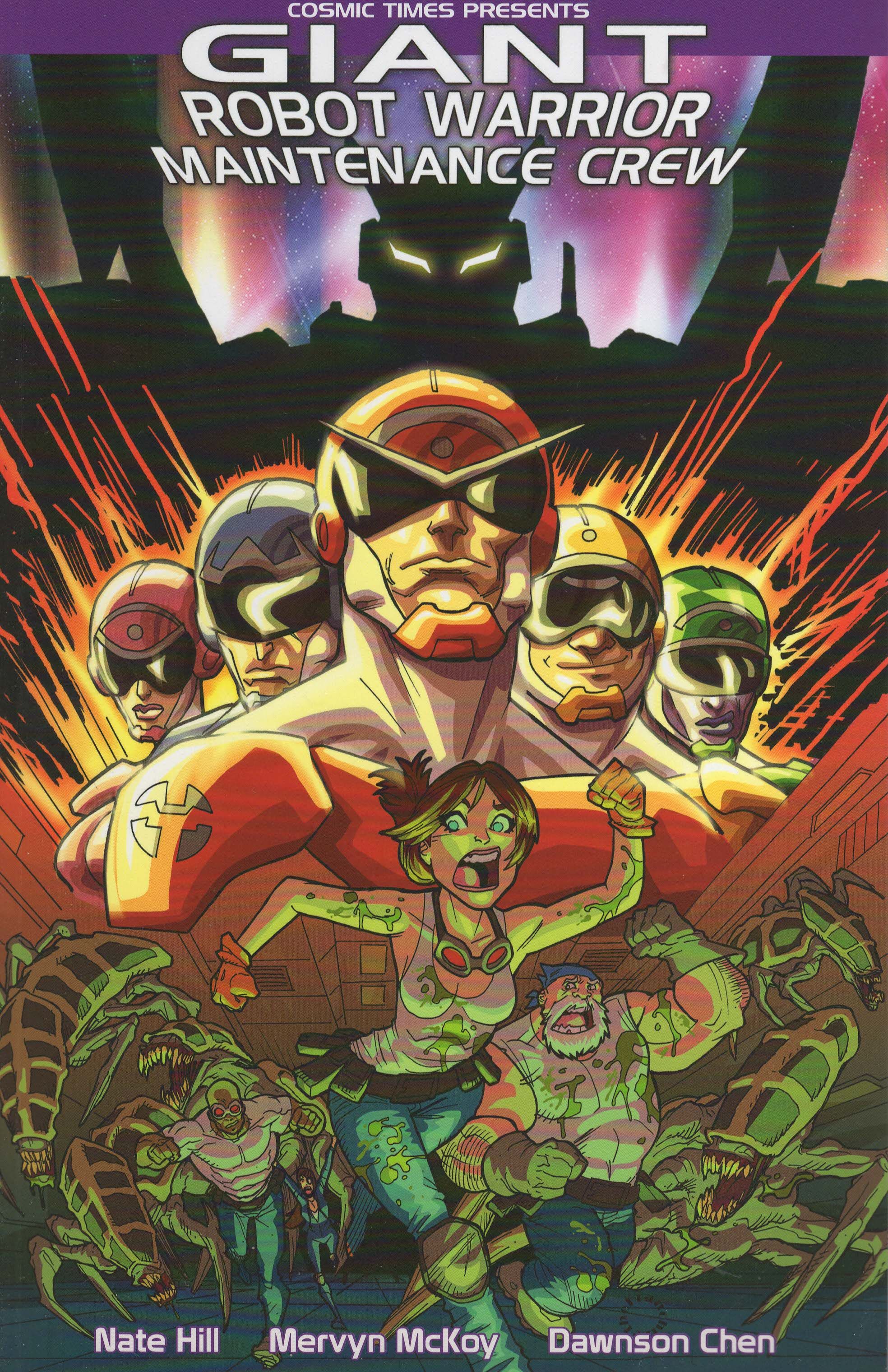"The problem's plain to see: Too much technology!"
Okay, so I didn't get a chance to do much of this in February, so this is ... a bit long. Sorry!
Conan volume 16: The Song of Bêlit by Paul Azaceta (artist), Jimmy Betancourt (letterer), Riccardo Burchielli (artist), Leandro Fernández (artist), Kat Larson (designer), Richard Starkings (letterer), Dave Stewart (colorist), Brian Wood (writer), Roxy Polk (assistant editor), Ian Tucker (assistant editor), Aaron Walker (assistant editor), and Dave Marshall (editor). $19.99, 154 pgs, FC, Dark Horse. Conan created by Robert E. Howard.
I haven't read any of the original Conan stories, so I'm not sure how Howard ended Bêlit's story, but if it was the same as how it ended here, that's a really terrible ending. I mean, here's a woman who ran a pirate crew for years and has shown how ridiculously capable she is, and that's how she goes out? I mean, I hope everyone knows that she dies, but I'm not going to give away how she dies, because it's just really disappointing. If that's in the original story, this is a classic example of where Wood should have changed it completely to make it fit better with the way Bêlit lived. This epic romance becomes all about Conan, and it really stinks. Wood did a nice job balancing the need for Conan to be the main character and not having Bêlit be completely dependent on him, but in the end, she goes out with a whimper and Conan avenges her death. Blech.
There's some nice art in this volume, though. The stories are exciting until we reach the end of Chapter Five. But man, it makes me angry. Oh well.
Rating: ★ ★ ★ ★ ★ ½ ☆ ☆ ☆ ☆
The Delinquents by James Asmus (story/writer), Kano (artist), Dave Sharpe (letterer), Fred van Lente (story), and Josh Johns (editor). $14.99, 102 pgs, FC, Valiant. Quantum and Woody created by Christopher Priest and Mark Bright. Archer and Armstrong created by Jim Shooter, Bob Layton, and Barry Windsor-Smith.
I was a bit bummed out by the end of these two series, as Archer and Armstrong and Quantum and Woody were the only two Valiant books I was following, so that was quite a blow when they both got the axe. But we got some nice stories, and now they get a nice send-off, as Asmus and van Lente give us a tale about hoboes. Yep. They do give us a good villain, Gerald Stano, who runs the Mondostano corporation (it's nothing like any real-world company!) - he's a weird hippie type who hires Quantum and Woody to find half of a hobo map, which is inked onto someone's buttocks (because of course it is) and happens to be in possession of one Armstrong, who got in good with the hoboes decades ago. It's a ridiculous story, made a bit more disturbing by Mondostano and some of its business practices, but it's generally just an excuse for the four protagonists to fight and argue and hang out with hoboes. Asmus does really nice dialogue, as it crackles with wit, and he does a nice job turning Woody into a mentor in depravity for Archer, who of course is still naïve about the world. Each character is true to his personality, and that leads to some good "Odd Couple" moments, with it feeling a bit fresh because the moments aren't just between the stars of the respective comics, but among all of them. It's a funny comic, which is nice, but there's also plenty of good old-fashioned violence for the kids. The team does a few nice things with the violence - early on, a man gets shoved into a thresher, and instead of the gory details, we get a silhouette of the machine with disclaimer writing around it to distract us from his horrible fate. In the climax, we get a double-page spread of the scene where the battle will take place, and at the bottom we get clip-out characters (and sound effects!) of everyone involved and an invitation to cut them out and pose them any way you want. Clever touches like that keep the tone light even as people are actually dying. Plus, there are plenty of hoboes.
Kano does very nice work with the art. The book is packed, so he has to use a lot of panels to tell the story, but his layouts are very nicely done. In a fairly broad comedy like this, his characters have to react well to each other, and he has no problem with that, either. He gives us good fight scenes, and he knows when to go a bit bigger to sell the moment. Like Asmus and van Lente, he has a good sense of humor about the entire thing, so his hoboes, for instance, are caricatures, but not to the point where he's mocking them - it's a bit more gentle than that. He does some clever things to simulate motion throughout the book, especially when the good guys fight some bad guys on top of a moving train, and he uses blacks quite well to contrast one of the more brutal bad guys with the lighter tone of the colors (which I assume Kano did himself, as none is credited). Generally, it's a well drawn superhero comic, which might not sound like a lot but is harder to do than it looks.
The good guys make a classic mistake at the end of the story, setting up a continuation if Valiant and the creative team want to do it, but this pretty much stands on its own well. It's not going to re-invent the genre or anything, but it's as enjoyable as the two ongoing series were, so it's a nice addition to your library of humorous comics. You do have one of those, right?
Rating: ★ ★ ★ ★ ★ ★ ★ ☆ ☆ ☆
Bang Tango by Joe Kelly (writer), Thomas Mauer (letterer), Rodney Ramos (additional inker), and Adrián Sibar (artist). $14.99, 127 pgs, FC, Image.
According to the back cover of this trade, this has been "remastered," presenting it "as it was always meant to be!" I'm not sure what that means - no colorist is listed in the credits, so I assume Sibar did it for this collection, although it's not a very bright book - there's a lot of black and white and very pale shades. Tanya and Richard Horie colored the book when it came out in 2009, but their names are not on the credits for this book. So I assume the original issues looked very different, and now I'm quite curious about it. (Sean Konot was the letterer on the original, too, and I'm not quite sure how Mauer changed things.)
I wasn't too interested in Bang! Tango when it came out, but I figured it might be cool to check out, and it is. I have some problems with the comic, but it's a pretty good noir tale, with lots of twists and turns, heists that go horribly wrong, double-crosses, and violence. I like noir tales, so I was entertained, but Kelly doesn't really do too much new with it. His characters slot pretty easily into tropes, and the gears of the story grind in a horribly predictable way - not "horrible" as in a bad story, but "horribly" as you just know things aren't going to work out for many characters, if any. Sibar's art is terrific - he creates wonderful characters, and in a book partially about dancing, his fluid pencils really give you an idea that Vincente and Mel are actually moving across the page. When he draws dancing scenes, he eschews panels and just places the main characters on pages surrounded by other images, either of them or other characters, creating beautiful tableaux that tell their own small stories. Sibar does a tremendous job making San Francisco come alive, and his coloring choices - a very basic palette, with a lot of black and white - makes the book feel a bit more timeless and even dreamlike. Considering that noir stories are often about people making misguided grabs at impossible dreams, that's not a bad way to color the book.
As I noted, Kelly's story is pretty garden-variety noir, which is fine but a bit disappointing because of what the book could have been. Kelly gives us a couple, Vincente and Mel, who are trying to move to Buenos Aires to set up a dance studio. Of course, they are saving money, but it's taking time. Vincente, of course, has a shady past, and when a link to that past, a girl named Autumn, comes back into his life, he's suddenly in a lot of danger. Autumn wants Vincente to do something for her, and of course Vincente says yes. Meanwhile, he has to keep his past and connection to Autumn a secret from Mel. And of course, it all eventually comes crashing down. Kelly does two things that should set it apart from a standard noir tale: Vincente and Mel dance the tango expertly, and Autumn is transgender, trying to get money for the surgery to get rid of her penis. These aren't unique twists, but they are clever, and it should make the book more "provocative," as the back of the book states. However, Kelly doesn't do much with either plot point. Dancing is just something that Vincente does that gives him a motive to raise money - it could have been anything, really. Sibar draws the dancing very well, but Kelly doesn't really get into it any more than just as a surface motive for Vincente going along with Autumn's plan. He does delve into the idea of a femme fatale being played by someone who was born a man, but even that isn't as developed as it could be. Sibar draws Autumn as a woman, and while Vincente exposes her penis at a crucial point, even Vertigo wasn't willing to show it! We don't get to see Vincente's reaction to discovering that Autumn has a penis - in flashback, we learn about their relationship, which Autumn didn't want to consummate, but the moment where he discovers why is glossed over. It's a fairly crucial plot point, but Kelly doesn't show it and how Vincente - who's fairly homophobic - reacts. Because of his attitude toward homosexuals (and, of course, that fact that he "protests too much," as one character notes), it would have been very interesting to see how he dealt with Autumn when he discovered her secret and why, when she shows up in San Francisco asking for his help, he does so instead of kicking her out. Yes, he needs money, but again, that's a facile reason, and Kelly doesn't delve too deeply into Vincente's obviously tortured psyche. Meanwhile, the gangsters that follow Autumn to San Francisco and who want revenge on Vincente are a twisted bunch, but again, Kelly just skims the surface of their depravity. It's strange - there's so much here that could turn this book into a really dark trip into a twisted psycho-sexual landscape, which might have failed utterly but probably been weirdly compelling, but instead Kelly just writes a standard noir tale with hints at something more disturbing. I was entertained by what he wrote, but I couldn't help seeing what might have been. I know saying "That's not how I would have done it!" is pretty cheesy, but it's frustrating with a comic that has so many characters with so many layers and Kelly opts to ignore them. Oh well.
It's certainly not a bad comic - there are lots of cool little things in it, and while it ends fairly predictably, it does a nice job wending its way toward that ending - but it has a lot of potential to be more. But hey, everyone likes a noir story, right?
Rating: ★ ★ ★ ★ ★ ★ ½ ☆ ☆ ☆
Deathlok: Rage Against the Machine by 40 (!!!) different creators, including Joe Casey and Leonardo Manco, who are the main creative team on the ongoing. I think I'll skip listing them all, if you don't mind. $34.99, 424 pgs, FC, Marvel.
The late 1990s were an insane time at Marvel - you could say the entire Nineties were, but the second half was increasingly batshit crazy, as Marvel came out of bankruptcy and forged a new path into the new millennium. The problems of the late Nineties in terms of comic book creativity were legion, too, as Marvel continued to allow their characters to change but began to get some pushback from readers, who seemed to prefer infantile versions of their favorite characters. So Marvel kept allowing their creators to push things forward, but in a completely chaotic way that paid homage to continuity but revealed how much harder that was to do as the years piled up. Call it millennial fever, if you want, but the end of the Nineties were a weird time, as Marvel, more than DC it seems, tried so many new things but flailed around at them a little. Marvel struck gold with "Marvel Knights," but some of their other initiatives didn't work out quite so well. Such was the case with their attempts to plug into the computer age with Deathlok, Warlock, and X-51. These three series combined to have 32 issues, with X-51 managing to last the longest, with 12 issues. Marvel eventually got their act together, but the late Nineties were weird, man.
The consequence of this is that a lot of the work from this time is uncollected, even for the big sellers like the X-Men. The two main X-books were a mess at this time, and collecting them probably isn't that high on the list of Marvel priorities, but it is interesting that they remain adrift. Casey's Deathlok story, which began when he was writing Cable, segued into whatever the hell Alan Davis was doing at that time in the X-books (I love Davis, but this was not his creative peak), and then went into the ongoing, doesn't scream out for a collection, either, but with the Marvel cinematic universe becoming more popular, I guess Marvel decided they'd chuck this out there even though Deathlok hasn't appeared on Agents of S.H.I.E.L.D. in a while and was a completely different character anyway. What the hell do I know about marketing? At least this is a complete story, and it's actually kind of fascinating how Casey gets to Deathlok's "birth." He begins with S.H.I.E.L.D. trying to figure out who Cable is and what kind of threat he represents, which means they end up sending their super-best-awesome agent after him, a square-jawed manly man named Jack Truman (Casey was probably reading Clancy or Ludlum when he came up with that name). Truman actually defeats Cable because Cable is seriously messed up at that point, but he feels bad about it because he figures out that Cable wasn't operating at peak efficiency. So he releases Cable so he can fight him, and most of a crashing helicarrier drops on Truman as a reward. Well, dang. Game over, right, Truman? Of course not, because this is S.H.I.E.L.D., and remember they have an ExTechOp division to turn men into cyborgs, which they do with Truman. They then put Truman's brain inside a new Deathlok, but when the Red Skull used Douglock to take over the helicarrier (I told you late Nineties Marvel was batshit crazy!), Deathlok seemed to gain some kind of consciousness. Then that consciousness jumped into a low-level S.H.I.E.L.D. worker to get out, and then it transferred into the head of a six-year-old boy (who, to be honest, acts more like a 10- or 11-year-old). In the interim, the Deathlok part got out, but eventually Truman and the robot were reunited, which Truman felt he needed to do but regretted almost immediately, because he was a mind trapped inside a robot, after all. It kind of cuts down on the dating life. Oh, and then the Ringmaster runs for president. COMICS, MOTHERFUCKERS!!!!
Casey has never worried too much about logic in his comics, which is why he's such a good comic book writer, in my opinion. He embraces the insanity, and for some stories (such as this one), he straight up French kisses and humps the insanity. In the Cable section of the story, a rogue S.H.I.E.L.D. scientist (are there any other kinds of scientists in comics, especially Joe Casey comics?) uses the techno-organic virus to create soldiers who take on the personalities of the original Howlin' Commandos. Because why not? S.H.I.E.L.D. basically firebombs Hell's Kitchen, and nobody seems to think this is strange, probably because they live in the Marvel Universe and parts of Manhattan are always getting firebombed (if I lived in the Marvel Universe, I'd live in Duluth or Billings or, better yet, Brisbane). S.H.I.E.L.D. later destroys Las Vegas, again just for the hell of it (yes, Deathlok is on the loose in Vegas, but they don't seem to consider all the people they're presumably killing just to stop it). Casey turns the Clown from the Circus of Crime into a professional assassin who walks around in his clown gear all the time and nobody, not one person, thinks this is odd behavior. And Nick Fury becomes a gangster kingpin. Like, an actual one, not because he's undercover or anything. Sure, he was hypnotized by the Ringmaster, but all Tiboldt told him was to go away for a while. It speaks volumes about Fury and Casey that "going away" for him meant turning the gangs of Los Angeles into an efficient army. In the end, Truman gets a happy ending, sort of, but the Deathlok prototype is still out there. I assume Marvel cleaned that plot thread up at some point.
The art is fairly typical of this time period - big and bold, with bright colors and attempts at computer effects that occasionally look good and occasionally look terrible. This was during José Ladrönn was pretty shamelessly aping Kirby (if you're going to pattern yourself after someone, go big), and his broad-shouldered, square-jawed warriors fits the gonzo fighting of the Cable arc but doesn't quite fit the darker tone of Casey's script, which is that S.H.I.E.L.D. is sending assassins into a heavily populated area to acquire Cable by any means necessary. Leonardo Manco's art is transitioning to the more heavily photo-tracing that he uses today (which is too bad, because his 1990s work is pretty good), and it fits the grimy tone of the underbelly of Marvel's universe, where guys like the Ringmaster hypnotize people into voting for him. Manco was apparently quite slow, and he doesn't come close to drawing the entire 11-issue series, so Marvel got Eric Canete to draw some of it, and his cartoonish, sharp style is in wild contrast to Manco's. Canete gets to draw the Clown a lot, though, and so his style doesn't clash quite as much as you'd expect, but it's still rather odd. As with a lot of Marvel comics (and DC, to a lesser extent) of the era, the artwork is grab-bag of styles, but overall, Casey gets some good collaborators. Jimmy Cheung, Andrew Robinson, and Rick Leonardi provide the art for the X-Men interlude, and it's fun to see the first two early in their career, while Leonardi does his usual solid job on the finale of the Red Skull story.
I don't know if this is a good story, per se, but Casey stories are pretty much always entertaining, and this one certainly is. It's very cool how he uses his run on Cable to backdoor a pilot, and it's nice that Alan Davis and Marvel editorial went along with it. This is the kind of historical document that you can give a comics newcomer and say, "Here's the 1990s - in all its glory and awfulness - in a nutshell." That's kind of cool.
Rating: ★ ★ ★ ★ ★ ★ ★ ☆ ☆ ☆
Wally Wood: Classic Tales of Torrid Romance by Wallace Wood with Martin Rosenthal and Harry Harrison. $39.95, 200 pgs, FC, Vanguard Publishing.
This collection contains some of Wood's earliest work, from 1949-1953 (he started on romance comics and moved to horror and science fiction in the early Fifties, so only the 1940s work in this is his "earliest work"), and it's interesting looking at it, because there's only some hints at the 1950s Wood art that would make him such an influence to generations of artists. It's certainly nice work, but it lacks the sexy flair that Wood brought to his slightly later stuff. As they're romance comics and therefore tell cautionary tales about wayward women (more on that in a bit), Wood doesn't get to draw them too sexily - there are probably only two or three drawings of women in bathing suits or unmentionables, and even their regular clothing is more conservative than later Wood women. They're attractive, of course, and Wood shows that even at this early age (he was born in June 1927), he knew what he was doing in terms of posing, body language, and position within the panels (there are a few ridiculously posed panels, but he had to cram a lot into the pages!). He's smart enough to use shadows well, as these romances hit snags and it seems like everything is lost, and Wood reflects that (some of the stories don't even end happily, which is interesting). These are melodramatic stories, of course, so Wood needs to plaster emotions all over the characters' faces, and for the most part, he does well with it. This collection doesn't include his greatest work, naturally, but it's a fascinating look at where he started and where he was going.
The stories are pretty terrible, unfortunately. I mean, they're perfectly fine for what they do, but from a distance of 65 years, they're terribly regressive and almost laughable. What we learn from this collection is that every single woman is conniving and insecure, while almost all men are paternalistic yet correct in everything they do. The women pine away for men or, almost as often, haughtily dismiss men before, in all cases, they learn their lessons about love and either live happily ever after or realize they've learned too late. No woman is allowed to work after they fall in love, even those who are proud of their work. In one story, a woman's desire to assist her husband in his work leads to a bridge disaster, which shows her, it does! Women are flighty, so they leap to conclusions that throw their lives into chaos even though, if they had just stopped and listened for a while, they would have realized everything was all right (usually because the man solved things). One disturbing story is an even more misogynistic take on The Taming of the Shrew (yes, even more misogynistic than that problematic play), as a father cheers on a brute who sexually assaults his daughter (she's very rude, so the man starts kissing her even though she protests) and who later spanks her on the street. Obviously, these are melodramatic, but they reflect the attitude toward relationships that were prevalent in the late 1940s and 1950s. Boy, it's so nice that we've moved past these attitudes, isn't it? The writers of these stories don't get credited, so I don't know if they were written by Wood (I doubt it) or someone like Al Feldstein, but while they're ridiculous in many ways and that makes them twistedly entertaining, they're also depressing when you realize that people in real life felt this way and many still do.
Still, the book is good to have as a relic of a bygone era and as an example of early Wallace Wood art, which is never a bad thing to see. If we judge just the art and the comics' historical importance, this comes off looking a lot better than if we try to judge it on the content of the stories. If you're planning on buying this, just remember that. You'll be okay.
Rating: ★ ★ ★ ★ ★ ★ ★ ½ ☆ ☆
Damian: Son of Batman by Brad Anderson (colorist), Andy Kubert (writer/artist), Nick Napolitano (colorist), plus Jesse Delperdang (inker), Jared K. Fletcher (letterer), Guy Major (colorist), Grant "You can't get rid of me!" Morrison (writer), and Peter Hamboussi (editor). $16.99, 122 pgs, FC, DC.
This is a completely inconsequential comic (keeping in mind, of course, that all comics are inconsequential, as is all of pop culture), and it's rather strange that it got made. Did DC want Kubert to stay in the fold, so they let him do this? I mean, it's not like he does a lot of work anymore anyway, and they haven't been upset about him doing work for Marvel in the past, but maybe someone in the office was scared he'd ditch them? I don't get it, because this is an utterly pointless book. There was no need for a four-issue series about how Damian avenges Dick Grayson's death. This is the epitome of grim-'n'-gritty, as Damian and Dick get blown up early in the book (with Kubert letting us believe it's Bruce for a while), Dick dies, Damian avenges him by killing bad guys, much to the dismay of Bruce himself, Jim Gordon (who is inexplicably a priest), and Alfred, who also dies (from exhaustion) in the course of the series. There's barely a narrative arc, it's full of bloody murder, and it makes very little sense (did Alfred really hire the "Jokerized" nurse who kidnaps Bruce?). Kubert's art is gorgeous, but that's about it. DC reprints Batman #666 in the back of the book, and even as subpar as that issue is, it's miles better than the mini-series. I just don't get it. Oh well.
Rating: ★ ★ ★ ½ ☆ ☆ ☆ ☆ ☆ ☆
Daredevil volume 2: West-Case Scenario by Grace Allison (colorist), Brian Michael Bendis (writer), Joe Caramagna (letterer), Matt Hollingsworth (colorist), Karl Kesel (writer/penciler), Alvaro Lopez (inker), Alex Maleev (artist), Tom Palmer (inker), Javier Rodriguez (penciler/colorist), Chris Samnee (penciler), Mark Waid (writer), Matthew Wilson (colorist), Sarah Brunstad (assistant editor), and Alex Starbuck (editor). $19.99, 136 pgs, FC, Marvel. Daredevil and Foggy Nelson created by Stan Lee and Bill Everett. Black Panther created by Reginald Hudlin and John Romita Jr. The Purple Man created by Stan Lee and Joe Orlando.
One problem with waiting for the trade these days is that even trades are getting smaller and more expensive, which is depressing. This is still cheaper than getting the individual issues (five issues of the regular series would be 20 dollars, and this includes the #1.50 issue), but the slimness of the single issues is making the trades slimmer too, and while someone like Waid knows how to work within the constraints of the 20-page single issue, these days, even trades feel vaguely unsatisfying. It's very frustrating.
Anyway, the #1.50 issue is utterly pointless - Waid's story, set in the future, is fine (and beautifully drawn), while Bendis's and Maleev's is a long quasi-justification for Women in Refrigerators, which is kind of weird. Despite the fact that they're both set in the future, they still seem to contradict each other, so it's bizarre that Marvel let them both in the same issue. Kesel's story about Mike Murdock is okay, but also forgettable. I'm certainly glad I didn't get this issue when it came out, because it's really not worth talking about it, even though the skill of the creators is there.
The main stories are good, as usual. During "Original Sin," Matt sees what he thinks is his father abusing his mother, but when he goes to find out what's what, she's been arrested for protesting against Wakanda, and she's quickly extradited there, so Matt has to go get her. Along the way, we find out that Matt was wrong about Battlin' Jack, of course, because one of the immutable laws of comics is that Battlin' Jack was the greatest person ever. Waid comes up with a decent explanation for what Matt "remembers," but it's one of those things that I wish he had just left alone. Domestic violence is a topic that superhero comics should probably avoid, as there's really no way to deal with it in that kind of forum. The second story is creepy for a whole different set of reasons, but because it involves the Purple Man, it doesn't feel as icky. The Purple Man used his powers on several women to get them pregnant, and then brought the kids together to form a family. They rebel against him, though, as it turns out that they're more powerful than he is, but only when they're close to each other. Waid gets out of the predicament a bit too easily, but it's still a good story.
Both of the main stories, in fact, point out the problem with 20-page stories, even when someone as good as Waid writes them. Just the loss of 2 pages (or, if we go older, 3 or 4) per issue is enough that it seems to speed things up a little. Matt gets beaten up and rebounds to victory in the second story a bit too easily, while the first one is sidetracked by the idea of domestic abuse by Battlin' Jack, so that Maggie's arrest and extradition to Wakanda feels almost like an afterthought. Waid tries to get a lot of subplots into the book - in the second story, Matt is offered a buttload of money to write an autobiography - and while I appreciate it, it feels like the main, superhero plots suffer because of it. I don't know - the pacing of a lot of superhero stories these days feels wonky, even though the 20-page issue has been standard for, what, five years now? But maybe that's just me.
Anyway, Rodriguez and Samnee are great, as usual. The comic looks wonderful, and it's entertaining. I'm probably just being cantankerous.
Rating: ★ ★ ★ ★ ★ ★ ★ ☆ ☆ ☆
Airboy Archives volume 3 by Jeff Albrecht (inker), Willie Blyberg (inker), Ken Bruzenak (letterer), John Clark (letterer), Kim DeMulder (inker), Chuck Dixon (writer), Mindy Eisman (letterer), Larry Elmore (artist), Michael T. Gilbert (writer/artist), Tim Harkins (letterer), Ken Hooper (artist), Gary Kwapisz (penciller), Julie Michel (colorist), Mark Nelson (inker), Graham Nolan (penciller), Mark Pacella (artist), Bill Pearson (letterer), Steve Oliff (colorist), Ron Randall (penciller), John K. Snyder III (artist), Carrie Spiegle (letterer), Dan Spiegle (artist), Tim Truman (writer), Stan Woch (penciller), cat yronwode (editor, original series), Justin Eisinger (collection editor), and Alonzo Simon (collection editor). $29.99, 374 pgs, FC, IDW. Airboy created by Charles Biro, Dick Wood, and Al Camy. Valkyrie creates by Fred Kida and Bill Quackenbush. Skywolf and the Heap created by Harry Stein and Mort Leav.
Chuck Dixon writes the introduction to this volume, and he uses it to write about his contentious political relationship with cat yronwode. He notes that the final story in this collection (which is not finished in this volume, oddly) was "allegorical," mirroring the Iran-Contra thing, and he and yronwode were of course on either side of it, even though he does admit that the scheme was "boneheaded" (Dixon does call Reagan "Ronaldus Magnus," though, so him saying yronwode was a bit extreme in her beliefs is veering into the pot calling the kettle black territory). The story he writes doesn't seem to mirror that scheme too much, as it's just an adventure story in which Airboy, Skywolf, and Valkyrie end up on three different sides in a contentious civil war. It's actually clever, as Dixon shows that in a war, the sides are often far less noble than they think they are, even if they're fighting for noble causes. Airboy, Skywolf, and Valkyrie end up in Bogantilla for different reasons, and they all end up fighting for different groups for what they think are the right reasons. Dixon, despite being a self-professed conservative, does a good job showing that everyone in the country has flaws and most of them have redeeming qualities (there are pure villains, of course, but as it's still early in the arc, it's hard to tell who will turn out to be really evil). Apparently, in the next volume we get stories in which he and yronwode, according to Dixon, "could find zero common ground," but I guess we'll have to wait for a bit to see what's up with that, won't we? I mean, unless you have the original issues, but I certainly don't!
Anyway, Airboy continues to be a very fun comic. In the first big arc, Dixon manages to include a resurrected villain, giant rodent bikers, zombie Nazi paratroopers, and Howard Hughes (I'm still not sure what he was doing there) and make it feel less like he just threw them in there in an effort to be "awesome" and more like part of the story, which is a neat trick. We also get a story about ballooning which includes a deadly virus, because of course it does. In the meantime, we get stories with Valkyrie, Black Angel, and the chick Skywolf fighting voodoo bad guys in the Caribbean, which gives Larry Elmore a chance to draw a lot of women in bikinis; we get fun back-up stories starring Skywolf in the 1950s, including one where he gets angry that an advertising company is using his image without his permission; a weird Mr. Monster story about the power of fiction; and a story where Airboy meets the Prowler, who is not the Spider-Man supporting character. The main stories are wonderful, full of the right mix of goofiness and real-world consequences, and Eclipse, as usual, got some very good artists to draw the series, as Kwapisz, Nolan, Elmore, Randall, Spiegle, Snyder, and Woch all do excellent work.
These Airboy archives are chock full of quality comics, and it's interesting to read about some of the backstage problems Dixon and yronwode had with each other. To be fair to Dixon, yronwode sounds really wacky, and I imagine she was even back in the 1980s. But she shepherded some great comics into our lives, and we should be thankful for that!
Rating: ★ ★ ★ ★ ★ ★ ★ ★ ☆ ☆
The Manara Library volume 6 by Iole Alessandrini (translator), Lois Buhalis (letterer), Alfredo Castelli (writer), Raffaele D'Argenzio (writer), Franco Gaudiano (translator), Milo Manara (writer/artist), Andrea Mantelli (writer), Mino Milani (writer), Tom Orzechowski (letterer), Valentino Rossi (writer), Kim Thompson (translator), Fernando Ventura (writer), Aaron Walker (assistant editor/translator), and Diana Schutz (collection editor/translator). $59.99, 318 pgs, FC/BW, Dark Horse.
Back when I was doing my Year of the Artist posts (check them out if you missed any!), I lamented the fact that Dark Horse was collecting stuff for their Manara Library in seemingly a haphazard way, as it certainly wasn't chronological. Therefore, the earliest work I had by Manara when I featured him was from 1976. Then volume 6 comes out ... and it has a bunch of stuff from 1974 and 1975. Damn you, Dark Horse!!!!!
So we get some interesting short stories from those early days in this volume, many of which wouldn't be out of place in one of the Vertigo anthologies we get today, as they're punchy and usually feature some sort of ironic plot twist. Manara's art is recognizable, naturally, but it's also far rougher than his later work, examples of which we also see in this volume. In this volume, we either get stories from the 1970s ("The Snowman" - which is absolutely gorgeous - from 1978 is the latest of those) or from the 2000s, which means there's an interesting gap between the two eras. Obviously, the more recent work is more refined, but Manara also uses more digital effects which add a "porny" sheen to the comics - Manara doesn't help that because of the way his females in later years tended to look alike, but despite the lack of, you know, actual porn in these comics, I'm talking about the veneer that a lot of modern comics have, where the digital coloring tends to make it shiny and, well, "porny." "Escape from Piranesi," which is kind of a silly sci-fi romp from 2002, is a good example - Manara's art is fine, but it's a bit too rendered, and the story ends far too abruptly. "Revolution" (from 2000) is better mainly because it's not colored except for some pale blues, so while Manara's story is a bit obvious (the revolutionaries become the authorities very easily, shocking!), the art blends that roughness that Manara had early in his career with the drawing chops he gained over the years. The oddest story in the book is "Forty-Six," which is from 2006. Manara collaborated with Valentino Rossi, a motorcycle racer, for a weird tale in which villains from a television network are trying to clone sports stars so that they control their rights perpetually. Manara's art is as slick as ever, but the digital effects and use of photographic references are a bit overwhelming - not so much when Jim Morrison (!) and Steve McQueen (!!) show up in the story, but when Manara shows the racing. Plus, there's a talking dog and a ghost chicken who acts a bit like Bat-Mite. Is that something Italians would be familiar with but doesn't translate? Oh, and Rossi's girlfriend loses her pants (and is, naturally, going commando) in the most ridiculous way in recorded history. I swear, some porn producers probably read that scene and threw up their hands and said, "Oh, come ON!!!!"
As you know, I'm a fan of Manara, so the fact that Dark Horse has released these is wonderful, even though I know he's not for everyone. This volume, as well as the six others ("The Borgias" is strangely not included with the rest, and I don't own the ones Dark Horse did collecting his straight porn), is a really nice cross-section of Manara's artwork, and they're the kind of books I'm glad I have, as they're very nice to look at even if you don't feel like re-reading them all the time. So while they're fairly expensive, they're a great investment. And even if some of the stories are a bit weak, every volume has stuff that's well worth a read.
Rating: ★ ★ ★ ★ ★ ★ ★ ★ ☆ ☆
The Mighty Thor Epic Collection volume 4: To Wake the Mangog by Vince Colletta (inker), Bill Everett (inker), Jack Kirby (penciler), George Klein (inker), Stan Lee ("writer"), Sam Rosen (letterer), Art Simek (letterer), Joe Sinnott (inker), Chris Fama (art restorer), Michael Kelleher (art restorer), Wesley Wong (art/color restorer), and Cory Sedlmeier (collection editor). $34.99, 446 pgs, FC, Marvel. Everyone in here was created by Lee and Kirby, with a few co-created by Larry Lieber.
There's not much to say about this collection of Thor comics (issues #154-174): I mean, it's pretty awesome, and Thor hurtles from adventure to adventure, pausing only to turn into Donald Blake occasionally and dazzle other doctors with his surgical acumen (apparently, in the Marvel Universe, you don't need to know anything about patients or even consult with them beforehand if you're brilliant - you can literally walk in off the street, say "Hey, can I operate on this dude?", and because you're so brilliant, everyone will just allow it) before he jets off again. The Mangog gets awoken in the first issue in the collection, and his story is the longest in the book, as it takes a whopping four issues before his threat is dealt with. Thor faces Galactus, Ulik the Troll and the Circus of Crime, the Wrecker, Pluto, the Infernal Man, the Crypto-Man, and Him, and it's all very dramatic and overwrought, as most 1960s comics, especially a Lee/Kirby joint, were. The collection actually speaks to the problems with a Thor comic - Mangog, for instance, is defeated because Odin wakes up from his damned nap and simply waves his magic wand. Odin punishes Thor (who succumbed to "warrior madness" when he fought Him) by making him find Galactus, but when Odin hears Galactus's secret origin, he just says "Well, that threat is over!" and returns Thor to earth. Zeus himself shows up and dispatches Pluto with his magic wand (those gods and their magic wands)! Despite a lot - a lot - of punching by Thor, a good amount of the time, he's somewhat ineffective. When you're dealing with gods, it's hard to come up with bad guys strong enough to fight them, and even the fertile imaginations of The Man and The King weren't enough. The most interesting stories in here are when Thor has to fight with something other than his fists ... no, not his own magic wand, you perverts! When he battles Ulik the Troll and the Circus of Crime, he has to be careful not to get hypnotized. When he fights Kronin Krask, he has to use his brains (and yes, I now believe that Kronin Krask actually succeeded in his quest to transfer his mind into a younger body, but in his hubris, he simply changed the spelling of his first name slightly and used it as his last name, giving us ... Brian Cronin!!!!!). The fights might not feature as many punches, but they're a bit more interesting.
Still, it's Lee and Kirby. You know they're good comics! There's Galactus fighting Ego, the Living Planet! There's Him deciding - without asking her, mind you - that Sif would make a good "mate" and Thor responding with: "Thou art mad! She be the goddess Sif! And I say thee - she be MINE!" without a hint of irony! There's Karnilla lusting after Balder and saying things like: "I am Karnilla - queen of the Norns - enchantress supreme! But, I am a woman first!" There's the Asgardians trying to kill anyone who exhibits the tiniest shred of cowardice yet still hanging out with Volstagg, who's the most cowardly of them all. I mean, really, Volstagg. You're a douchebag. Plus, there's phenomenal Kirby art. But that shouldn't be surprising.
These are the kind of comics that are good to own even if they're somewhat silly. I'm not sure why I haven't gotten the earlier Thor Epic Collection yet, but I'll have to remedy that!
Rating: ★ ★ ★ ★ ★ ★ ★ ½ ☆ ☆
Birthright volume 1: Homecoming by Andrei Bressan (artist), Pat Brosseau (letterer), Adriano Lucas (colorist), Joshua Williamson (writer), Helen Leigh (assistant editor), and Sean Mackiewicz (editor). $9.99, 118 pgs, FC, Image/Skybound.
Our first Joshua Williamson comic this month is Birthright, which is pretty darned good. Williamson takes all the fantasy tropes we expect and turns them on their head a little, and the result is a tremendously entertaining book. The first few pages introduce us to a family, with Aaron and Wendy the happy couple and Brennan and Mikey their two charming sons. Aaron is out playing catch with Mikey to distract from the surprise birthday party waiting for him at home, and he tosses a baseball a bit far into a forest, from which Mikey does not return. (This is just another reason why surprise birthday parties are evil. Trust me - no good ever comes from surprise parties.) A year later, people suspect that Aaron killed Mikey, Aaron becomes an alcoholic, Brennan gets in fights at school because kids pick on him about his brother's disappearance, and Wendy files for divorce. However, the FBI agent investigating the case brings them together at the police station, where they find a man dressed in armor who was found in the forest. Hey, it's Mikey! Yes, Mikey has spent years in a fantasy world called Terrenos, and now he's back. They get some proof that it's him, but before they can get absolute proof, Mikey busts out (he's a mean-ass warrior) and goes on the lam, claiming he needs to stop five mages from opening the portal between worlds and allowing the bad guys to invade. Yeah, that has to suck. Of course, that's not the end of the surprises, but you'll have to read the book to find out what they are!
Williamson does a really good job with a pretty sprawling story. He needs to introduce the family quickly and sketch out their personalities, so when Mikey returns, what happens isn't terribly unexpected. Meanwhile, Mikey tells various people what happened to him in Terrenos, so we slowly fill in his history as we go along, and it's clever that Williamson does it this way, because we can view what happened to him during his "year" in the other world (where, obviously, a good 20 years or so have passed) with the knowledge of what's going on right now. Whenever we get someone telling a story in a comic, we have to be aware that they might not be a completely reliable narrator, and Williamson doesn't hedge around with that. We'll have to keep it in mind going forward, which adds a nice layer to the entire thing. So we're getting a family drama (I will bet a whole dime that Wendy and the FBI guy are sleeping together) along with two different adventures - Mikey's adventure in Terrenos, where he's the "chosen one" fighting against the mad god king, and the one in the present, where he's trying to stop the mages and keep away from the FBI in the process. It makes for a fine adventure that could go in a lot of different directions, although one revelation that comes at the end isn't particularly surprising.
The art is superb, too. Bressan's work is fantastic, as he does a great job with the fantasy elements and the "mundane" elements, which is crucial in the book like this. He comes up with amazing creatures like the razorbeast, but his characters look like real people, too, so he's comfortable with the human drama. The page where we see all of Mikey's weapons laid out is wonderful, because Bressan makes them all fantastical knives and swords but shows how much they've been used, too, implying all the violence that Mikey has seen since he disappeared. Lucas's colors are tremendous, as well, as we get warm tones early on to set up the idyllic family life that is about to be shattered, while his use of "special effects" throughout to indicate magical weapons and spells is wonderful, contrasting nicely to the solid, even boring hues of the "real" world. The art on the book is great, and it makes Williamson's story resonate even more than it already does.
Williamson has a nice set-up for a decent run, but it's also bound by Mikey's quest, which provides an "end point." So he can go as long as he wants to (or is allowed to), but it's not open-ended, which is also nice. Birthright is really good, and it just shows that Williamson is a writer to watch.
Rating: ★ ★ ★ ★ ★ ★ ★ ★ ½ ☆
Nailbiter volume 2: Bloody Hands by Adam Guzowski (colorist), Mike Henderson (artist), John J. Hill (letterer), Joshua Williamson (writer), and Rob Levin (editor). $14.99, 104 pgs, FC, Image.
The other Williamson book is Nailbiter, the first volume of which was quite good. This one isn't quite as good, but it's still a fine comic. Part of the problem is that the first arc felt more focused, and perhaps Williamson didn't know it would be popular so he wanted to get going quickly, while now he can meander a little. Because this volume does meander just a bit, but that doesn't mean it's bad.
In case you don't know the premise, there's a town in Oregon called Buckaroo (I'd say that was a dumb name, but Oregon actually has a town called "Boring," so, you know) from which 16 serial killers hail. The latest, a dude called the Nailbiter, was acquitted on all charges, which brought the town to national attention. Nick Finch, an FBI profiler, has come to the town to find his friend, another agent, who thought he had discovered something about why the town spawns so many killers. Of course, that dude, Carroll, disappeared, so Finch and Sheriff Shannon Crane go looking for him. They find him, but he's comatose and someone cut off his arms and legs. Meanwhile, there appears to be a new killer, killing townspeople, which has never happened before - the "Buckaroo Butchers" always killed away from home. So it's a big mystery!
The first volume was totally focused on Finch's search for Carroll and introducing the new threat. This volume gives us stories about different people, all tying into the weirdness of the town. A woman arrives in Buckaroo to give birth so that her son will grow up to be a serial killer and she can become famous. She is, naturally, a bit unhinged herself, which is kind of the point. Then, Brian Michael Bendis shows up, researching a comic on serial killers only to be scared out of town. Williamson doesn't bother to hide the fact that he's homaging Warren Ellis's appearance in Powers, as someone at a Bendis signing has a copy of that issue. It's a gimmick, but Williamson does push the narrative along a little bit while also examining the consequences of being related to a serial killer. Then we get two more weird people who aren't killers but have been affected by the town nonetheless - one who believes dying bees have something to do with the strangeness of the town, the other one who believes he has to kill a bus full of children so they don't grow up to be serial killers. None of the stories are bad, exactly, but they do feel a bit scattershot, and by the end of the volume, when Finch decides to interrogate Edward Warren, the Nailbiter himself, it feels like Williamson is pushing up his sleeves and getting back to business. I know that all of this will probably tie together eventually and even if the stories are just one-offs, like the tale of woman who wants to give birth in Buckaroo, they're perfectly good stories, but I can't help what I feel, man!
Henderson, who teamed up with Williamson on Masks and Mobsters, is doing very good work here, as he has a nice, solid, gritty style that works well with the darkness of the tone. He's not asked to do too many fancy things, but his storytelling is solid, and the few fancy things he does - like the many people responding to Bendis's questions - are done well. Unfortunately, Williamson set this in Oregon, so Guzowski's colors tend to be drab, and the book is often ... I don't know, rain-colored. You know, like when it's raining late in the afternoon in the winter, and it's not dark yet but it's just so damned gloomy. Believe me, a lot of the Pacific Northwest looks like this, but it's kind of annoying that Guzowski has replicated it so well!
While I don't like this volume as much as the first one, there's nothing here to make me stop reading. Williamson obviously has a big plot in mind, and his writing is good enough that I'm happy to read along while he shapes it. Birthright is a bit more adventurous, but Nailbiter is pretty creepy, so you can pick your poison!
Rating: ★ ★ ★ ★ ★ ★ ★ ☆ ☆ ☆
All-New Ultimates volume 2: No Gods, No Masters by Jordie Bellaire (colorist), Clayton Cowles (letterer), Michel Fiffe (writer), Giannis Milonogiannis (artist), Terry Pallot (inker), Amilcar Pinna (artist), Lorenzo Ruggiero (inker), Esther Sanz (colorist), Le Beau Underwood (inker), Nolan Woodard (colorist), Emily Shaw (editor), and Sarah Brunstad (collection editor). $17.99, 120 pgs, FC, Marvel. Miles Morales created by Brian Michael Bendis and Sara Pichelli.
I wasn't too impressed with Fiffe's first six issues of All-New Ultimates, but it got cancelled with issue #12, so I figured I'd check out the second volume to see if it got any better. If I didn't like it, no big deal. Well, it's still not that great. I mean, it's a serviceable superhero comic, with Fiffe throwing a ton of stuff at the wall to see what sticks, but it's weirdly inert for a comic where so much happens. The overall arc is about the team's fight against Scourge on the one hand and the Serpent Skulls on the other, and both villains get their part in this volume, but the team also fights Vermin and a group called the Femme Fatales, who are working for a mysterious person that we never see or even find out anything about. Fiffe introduces Terror, Inc., just for the hell of it, but again, it's just window-dressing and callbacks to the "real" Marvel Universe. There's nothing terribly interesting about any of the characters Fiffe is working with, and he doesn't do much with them. He just points them at bad guys and they fight. Maybe it's a consequence of not knowing the fate of the comic, but that's not a great excuse. It doesn't help that Milonogiannis is really not suited to be a superhero artist, and his three issues are sketchy at best and incoherent at worst. Amilcar Pinna has a clean, solid line, but his work lacks the personality that Milonogiannis's does. So we have an idiosyncratic artist whose work isn't really great for superhero action, and an artist whose work "fits" the tone of the book better but feels soulless. It's an annoying combination.
Fiffe has gotten gigs on the strength of Copra, which is fine, even if I think Copra is the tiniest bit overrated. This book seems to be in that vein, as Fiffe seems to want to homage some things that have worked in the past, but because Copra is his own thing and his art is part of its charm, it works better than this comic. I hope he has more in his arsenal, because this kind of thing can get old very quickly. Oh well.
Rating: ★ ★ ★ ★ ★ ☆ ☆ ☆ ☆ ☆
Courtney Crumrin volume 7: Tales of a Warlock by Ted Naifeh (writer/artist), Warren Wucinich (colorist), Jill Beaton (series editor), and Robin Herrera (collection editor). $24.99, 114 pgs, FC, Oni Press.
Naifeh's coda to his Courtney Crumrin stories focuses on Aloysius Crumrin, Courtney's uncle, and his "secret origin." If you've been reading the Courtney Crumrin tales, this volume is fairly unnecessary, except for the fact that Naifeh can tell a story well and his art is always a treat. We don't really learn anything new about Aloysius - he's trying to keep Hillsborough off the radar of the evil men who want to stamp out magic, and he tracks down sorcerers who go rogue and use magic outside of Hillsborough. It's nice to see a young Aloysius, one who is interested in romance and is fairly sprightly, and Naifeh's sense of humor is a bit more unsubtle in this comic than in the "regular" Courtney titles - they've always had humor, but in this volume, we get someone like Godfrey "Goose" Daniels, the witch hunter, who's fairly ridiculous even before he gets turned into an actual goose. The two stories in this volume feel a bit underdeveloped, to be honest - Aloysius falls in love with Alice Crisp, the daughter of a man who heads a witch-hunting organization, but Naifeh doesn't do too much with the romance before he wraps it up, and it makes Aloysius less of a tragic hero than he should be. The bad guy is revealed and his big plan gathers speed fairly late in the game, and that means his defeat isn't really all that impressive, either. That's why it's a bit unnecessary - we can infer plenty of this from Old Aloysius in the "main" books, and we don't really need to know what Aloysius went through to get there.
Despite that, it's a nice little comic. Naifeh's art, as I mentioned, is always nice, and the stories are entertaining. They just feel a bit slight, that's all. I encourage you to catch up with Courtney Crumrin, because it's a nice series, but if you want to skip this, I don't think you'll miss anything.
Rating: ★ ★ ★ ★ ★ ★ ★ ☆ ☆ ☆
Giant Robot Warrior Maintenance Crew by Dawnson Chen (colorist), Nate Hill (writer), and Mervyn McKoy (artist). $9.99, 68 pgs, FC, Cosmic Times.
As I mentioned when this trade came out a few weeks ago, I ordered all three issues but my store didn't get #2, so I had to get the trade. Diamond makes Greg ANGRY!!! But the trade is only 10 bucks, so that's fine with me. And I get to read it all at once!
I've always liked comics that take place in a standard genre universe but deal with non-genre things. You know, like Damage Control (which got name-checked in Fiffe's All-New Ultimates, BTW). It's probably why I like Astro City so much - even though Busiek still writes superhero comics, he looks at superheroes from different angles, and it's not even always about superheroes. So the premise of this book is genius: there's a Voltron-esque robot powered by five pilots fighting bad guys across the galaxy, and this comic asks "Who keeps the giant robot running smoothly?" So we meet Erica, who was rejected as a pilot for the robot - called "Herotron" - and instead ends up on the maintenance crew. She quickly learns that it's far from glamorous. The pilots aren't exactly shining examples of heroism, and their robot warrior is in constant disrepair. Plus, everyone is a little bit crazy because their lives are constantly on the line but no one gives them any credit and their budget is always low. And so the hijinks unfold!
Hill does a really nice job with the concept. The book is quite funny, and Hill gets perilously close to depth when he alludes to the idea of the one percent (the pilots) and those people who do the real work (the maintenance crew). He filters the class conflict through loopy situations, but it's still there, and while he doesn't have time to really develop the pilots too much and so they remain stereotypes, he still has some nice points of view about the people who receive the glory and what goes on behind the scenes. The characters relieve stress in all kinds of ways - my favorite is the dude who handily speaks in narration - and that leads to some interesting solutions to problems later on, like when the one dude gets the robot guarding the access to the cockpit drunk (it's a comic, so of course robots can get drunk). Hill does a good job with Erica, as she is equally freaked out by the craziness but able to think on her feet, and we can see why she tried out for the pilot position and even why she got the job on the crew.
McKoy's art is typical of a lot of indie comics, in that the action parts tend to be a bit stiff and the interactions between characters tend to be better. McKoy does a really good job with Hill's humor, as he gives each character a unique look and does facial expressions and body language quite well. When the action comes, he's not quite as good, but it's not terrible, so there's that. He makes the inside of a giant robot feel claustrophobic, which is the point, and he's able to show the difference between the grunginess of the crews' area and the pilots' area very nicely. Part of the humor of the book comes from McKoy's ability to make the characters react in fun ways to the situations in which they find themselves, and it adds nice depth to the comic.
Giant Robot Warrior Maintenance Crew is fairly slight, but it's still pretty entertaining, and it would be interesting to see more stories about this crew and this robot warrior. For now, you can track this down!
Rating: ★ ★ ★ ★ ★ ☆ ★ ½ ☆ ☆
Well, I was hoping to get all of the March trade paperbacks and such into this post, but it's just not going to happen. That means next month's post will be really long, as well! I hope everyone has a nice day, and may your search for more comics to read be fruitful!

